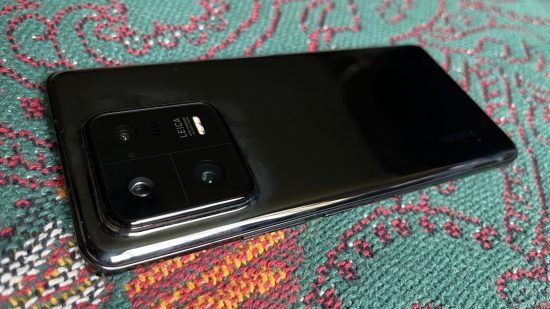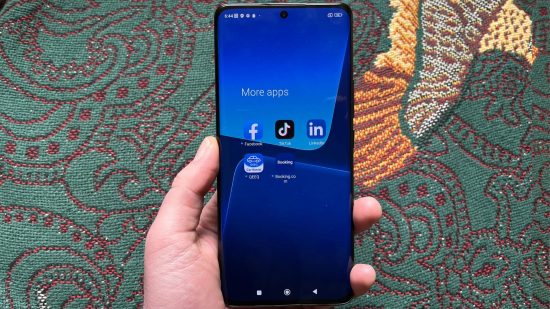It’s a bit weird switching phones around all the time. Sticking a sim card into a phone with a different Android interface, form factor, and other small uniquenesses can make you feel all off balance – like you’re on a boat.
So, instead of embarking on a journey so long I get my sea legs, I’ve chosen to just spend a week with the Xiaomi 13 Pro. Think of this as “Xiaomi 13 Pro first impressions: Extended Edition” – a little extra but not the full-trilogy Blu-ray steel book boxset.
The Xiaomi 13 Pro is the new flagship from the Chinese company that’s struggling to break into the UK market and isn’t even selling its 13 series in the USA, as has been the trend for a while now.
Why you can trust our advice ✔ At Pocket Tactics, our experts spend days testing games, phones, tech, and services. We always share honest opinions to help you buy the best. Find out how we test.
If you’re not in the USA, the Xiaomi 13 Pro launched in Europe and the rest of Asia on March 8, following its Chinese launch in December last year. It costs £1,099, almost twice the Chinese price of ¥4999 (around £600) – making the proposition a unique one. But is it one of the best gaming phones?
For comparison with two flagship smartphones, the iPhone 14 Pro starts at the same price, though of course with far less RAM, while the Samsung Galaxy S23 Ultra starts at £1,249, though the S23 Plus still competes handily at £1,049. Xiaomi is not massively undercutting the competitors over here, if at all, and that makes a difference.
So, with all that upfront, what’s it like to use? Well, starting on the outside, the Xiaomi 13 Pro is a hefty hunk; a big ol’ slab of pristinely cut, fingerprint-magnetic ceramic, aluminum, and glass, with a similarly chunky camera bump housing the headline attraction – the Leica camera collaboration.
It’s generally lovely. If you like curved-edge screens, this has it (I don’t like them but that’s okay). If you like a big screen, this one is massive. If you like high-quality materials this feels luxurious. Externally, it’s mostly a win.
Why I say mostly, is because it’s a tad too hefty for my taste. I get to play with a lot of different phones, but my main phone is an iPhone 13 – I don’t think I could go much bigger for my day-to-day tool. But for people that like big phones, which seems to be everyone nowadays, this should be comfortable.
Also, when I say that the camera bump is hefty, I mean it. My controller attachment which can fit an iPhone, Samsung Galaxy S22, and almost every other smartphone, doesn’t have a wide enough slot for the Xiaomi 13 Pro due to the width of the camera bump. This is fine by me, but it may not be fine by you.
Once you switch the thing on the screen impresses immediately. Beyond a little hole-punch camera it’s an edge-to-edge, near-bezel-less beauty. It’s a 1440 x 3200 120Hz AMOLED, with an excellent pixel density and a wild 1900 nits peak brightness. It’s top-tier.
It’s combined with adaptive refresh rate software, meaning you don’t have to worry as much about battery life without sacrificing slick animations and easy reading. Plus, with 120W fast charging offering a full battery in 19 minutes, any use-time worries should barely exist.
To get beyond the lock screen you have three methods – password, fingerprint, or facial recognition. I wouldn’t use the facial recognition if I were you – and the OS Miui 14 even mentions it’s less secure if you try and set it up – and the fingerprint scanner is so snappy it’s definitely a better option.
Unlike Samsung’s ultrasonic fingerprint sensor – one that creates a 3D map of your fingerprint – Xiaomi has the standard optical fingerprint sensor. This lights up bright to get a look at your finger skin and makes sure it matches the stored data. It’s super speedy, and I never had any issues with it, though callouses, scars, or moisture may be able to trip it up.
Now that you’ve unlocked your phone, it’s time to delve into the worst thing about the Xiaomi 13 Pro, or really any Xiaomi/Redmi/Poco phone – Miui 14. Sure, the phone comes packed with pre-installed junk (most of which you can uninstall but still feels a little trashy to see the Booking.com and QEEQ car rental apps on first setup), but the main issue is just general use.
Using Miui 14 feels weird. This phone has more than enough power – which we’ll get to in a minute – but occasionally the home screen resets, swipes stutter, and the overall user experience just feels second-rate. It has improved over the years, but it’s still not good enough.
But, I’ve only spent a week with the phone, and as a daily iPhone user, Android is already different enough. Miui 14 is a weird Android, so maybe that’s just a step too far for me. So, let’s just imagine that you, yes you, can get over it, and focus on what it’s like to play video games.
The size and quality of the screen combined with the generally comfortable shape of the Xiaomi 13 Pro set it up for playing games quite nicely, though its weight is likely too much for longer sessions.
Then, on the inside, we’ve got the Snapdragon 8 Gen 2. This is the latest Snapdragon chip, only just beaten by the specific calibration for the Samsung Galaxy S23 Ultra – which you can learn more about in our chat with the EVP, Head of Mobile R&D, Samsung’s Won-Joon Choi interview – and it’s more than enough for every game you want.
Call of Duty Mobile, Genshin Impact, and Fortnite all run with high framerates on max settings. I had no hiccups, and the phone never felt hot – only a tiny bit warmer (it’s usually ice-cold to the touch). Meanwhile, the less demanding likes of Marvel Snap breeze by without making this thing sweat.
This power can also translate to wonderful emulation. I got Aether up and running and ran around a bit in the PS2 game Raw Danger, not the easiest videogame to emulate, and saw zero issues, which surprised me. Don’t go and play Raw Danger on a phone, but if you want something that can emulate PS2, this can.
So, the chipset feels a little like overkill for games we can play right now, but it sets you up for more demanding titles if they arrive in the future. It also makes day-to-day use a breeze, when the operating system isn’t getting in the way. Seriously, this speed combined with the high refresh rate makes everything so wonderfully zippy.
What do we think of the Xiaomi 13 Pro after one week? Well, it’s excellent and expensive. It’s a little cheaper than the Samsung Galaxy S23 Ultra, but that has a little extra polish and power all-round, and it’s the same price as the iPhone 14 Pro, which isn’t Android.
So, ask yourself, what do you want? If it’s gotta be Android, and cannot be Samsung, and has to be cutting-edge, near-best tech, this is it. But that feels like a niche. And given the USA can’t pick up this phone, it’s likely to remain niche. You won’t be disappointed if you pick it up, but I can’t quite see where in the top-tier Android market it slots. It just sits in an odd position.




